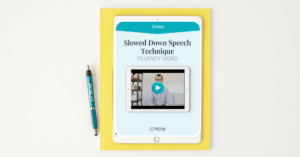Listen on Apple Podcasts Listen on Spotify
This Week’s Episode: The Impact of Stuttering
I’m excited to continue this month’s series on assessing stuttering with Stephen Groner! So far we’ve covered getting started with fluency evaluations and assessing speech fluency.
This week, we’re taking the conversation to the next level and chatting about how to assess the impact of stuttering — specifically, why feelings are an important part of the picture.
Stephen was very excited to share his thoughts on this topic and I’m excited to jump in! In this 12-minute podcast, Stephen walks us through his process for assessing feelings and gathering information from familiar listeners to help determine the impact of stuttering, so that we’re set up to make the best treatment recommendations possible.
He shares some standardized tests and other tools that we can use to gather this information as well.
Let’s get the convo started!
Tools used to assess the impact:
🔨 Overall Assessment of the Speaker’s Experience of Stuttering (OASES)
🔨 KiddyCAT (3- to 6-year-olds)
🔨 Communication Attitude Test – CAT (6- to 15-year-olds)
🔨 How satisfied are you with your speaking abilities? (Scale of 1-10) Stephen’s One page Stuttering Assessment
✨”When you’re assessing stuttering, you should assess fluency — and — you should assess their feelings toward their speech in some way.” – Stephen Groner ✨
Want to learn more about fluency therapy?
→ Hear more from Stephen on Instagram.
→ Print off Stephen’s one page Stuttering assessment ✨For 20% off use code: MONEYROCKS ✨
→ Are you an SLP Now Member? Check out our Fluency Bootcamp in the SLP Now Academy.
→ Listen to this podcast: Tackling Stuttering Treatment with Special Populations
→ Check out the SLP Podcast with the Fluency Queen, Lauren LaCour Haines!
→ Discover how to make planning + prepping your fluency treatments a breeze with the SLP Now Membership.
Here’s what to expect this month:
Here’s what to expect this month:
November, 1: Assessing Stuttering: Getting Started
November, 8: Assessing Stuttering: Speech Fluency
November, 15: Assessing Stuttering: The Impact
November, 22: Assessing Stuttering: Making Recommendations
Subscribe & Review on iTunes
Are you subscribed to the podcast? If you’re not, subscribe today to get the latest episodes sent directly to you! Click here to make your listening experience auto-magic and as easy as possible.
Bonus points if you leave us a review over on iTunes → Those reviews help other SLPs find the podcast, and I love reading your feedback! Just click here to review, select “Ratings and Reviews,” “Write a Review,” and let me know what your favorite part of the podcast is.
Thanks so much!
Transcript
Speaker 1: Hello there and welcome to the SLP Now podcast where we share practical therapy tips and ideas for busy speech language pathologists. Grab your favorite beverage and sit back as we dive into this week's episode. Welcome to the SLP Now podcast. This week we are continuing the conversation with Steven, and last week we talked about assessing speech fluency and now we're going to chat about assessing the impact of stuttering. And I know Steven's super excited about this topic and I am too.
Steven: Love it.
Speaker 1: Steven, can you give us a walkthrough of how you would navigate this?
Steven: Yes. So when you're assessing stuttering, you should assess fluency in some way. You should assess their feelings toward their speech in some way. It really helps to augment it with some kind information from familiar listeners like mom or dad or teachers, and then use those three things, fluency feelings and familiar people ratings to land at the functional impact overall of stuttering on their life. So we've done fluency and now we'll talk about how to assess feelings and how to gather in information from familiar listeners. So thankfully there are a lot more things coming online to help us assess the gray kind of vague and fuzzy things about stuttering that isn't just simple speech fluency. And there are some really good standardized assessments. Standardized assessments are great. Of course we know that they've been standardized. The cons of them are that they tend to be expensive, which I know just doesn't work for some of us and they tend to be a little more time consuming.
So you sort of have to balance all the good that can come from a standardized assessment of stuttering impact or feelings about speech with those cons. So I'll walk you through some of kind of the top tier standardized assessments out there and then what I do. So probably the one that people will be most familiar with is the OASES, the overall assessment of the speakers experience of stuttering. This was made by J. Scott Yaruss and his team, it's definitely the one that is used the most in research and it does some really cool things. It gives you based off of client answers to quite a lot of questions on a Likert scale, it gives you a score for general kind of perceptions that the client has about stuttering, a score about the client's reactions to stuttering, a score for difficulties with co communication in daily life situations and then from those three scores it gives you an overall impact score on their quality of life. And that is a great score to have.
The cons are this test takes so long for me to administer. For school-aged kids, they have to answer I think it's 60 questions on a Likert scale, which takes me about 30 minutes if not more, like 35 or 40. For teens, that goes up to 80 items on a Likert scale and for adults it goes up to 100 questions on a five point Likert scale. It gives you really good scores, but I have spent an hour with kids doing it and I just don't always have that time. So then I'm bummed because I don't get those really great scores. But if you can't pay for the test itself or for the forms as you run out or you don't have the time for it, there is another one that I like as well. It's not quite as expansive and comprehensive in scope, but it's still pretty good and it's called the CAT, the Communication Attitude Test.
They have one called the Kitty CAT, which is for three to six years old. The CAT is for six to 14 or 15 year olds and then I think it's called the CAT A or something for adults. And while you can't purchase it on its own, it is subsumed in the BAB, the behavior assessment battery, which I think is kind of funny that you can't just get it on its own. But the good thing is that the BAB is only about 30 bucks. So if you can get that, then you'll get the CAT which is inside of it. Now the CAT, I think for the Kitty CAT, it's 10 or 12 questions, for the CAT for school age kids, I think it's 30 or 32 questions, for adults I forget how many questions it is, but all it is they answer a yes or no question, either yes or no, and then you add up all the yeses and the no's and that gives you a score.
So for instance, answer this with true or false. Sometimes my words stick in my mouth when I talk, true or false. If they say true, that's a point for stuttering. My classmates think that I talk funny, is that true or false? So that'll kind of tell you if they say true, then it means that they know that they get some kind of reactions to the way that they talk. People sometimes finish my words for me, true or false. So while it's either 10 or 12 questions or 30 questions, it's pretty quick, it's just true or false. And from that you get a standardized score based off of samples of peers their same age of, "If you don't stutter, this is your average score with standard deviations. If you do stutter and you're this age, this would be your average score and standard deviations." And you can see where your client falls on those scales. I would say that's the most cost effective and time efficient yet still to get a standardized measure of impact of stuttering or feelings toward stuttering.
But I've actually found... so I use an informal measure of assessing feelings about stuttering and I call it my 10 point stuttering scales. You guys, if you haven't used 10 point scales in therapy, much less stuttering therapy, you are missing out. You get a numerical score for any variable that you could think of that is extremely personalized to your client. And yes, they're "informal and not standardized," but I honestly think that they're the best ones. So what I did is I read through the literature and I picked nine things to rate on a 10 point scale. So that's pretty quick and they ranged from how stuck do you feel when you speak on a 10 point scale with zero being not stuck at all, one being almost never stuck and 10 being stuck all of the time, to how satisfied are you with your speaking abilities on a 10 point scale with zero being not satisfied at all, one being extremely unsatisfied and 10 being perfectly satisfied, to how much do you enjoy speaking to, how frustrated do you get when you talk, to how much does stuttering scare you?
And you can get really good numbers from this that you can see change with treatment. It's the best time saver that I've found to assess these kind of gray, vague and fuzzy things, but still get some kind of a numerical score even if it's not standardized. And on top of those nine things about stuttering, I also asked two questions about their desire to change. Because if they don't have a desire to change and they're seven years old or older, you might as well just not do therapy. So I ask them how much they want to change the way that they communicate on a 10 point scale and then after that I ask, "How hard are you willing to work for that on a 10 point scale?" And if they're like, "I 10 out of 10 want to change the way that I speak and I am willing to work nine out out of 10 hard to get there," then I know they are raring to go for therapy.
If they're like, "I 2 out of 10 want to change the way that I talk and maybe two or three out of 10 want to work hard for it," then maybe now wouldn't it be the best time to get really great outcomes from stuttering therapy. But you can literally assess anything with a 10 point scale. I just picked the ones that see most relevant from the literature and I put them into... so in total it's an 11 question formal self-report rating scale measure that's 11 questions long and I use it all the time and I love it. But of those three things or some kind of configuration of more than one, you should get a pretty good score in some way of their attitudes towards speaking, their feelings towards speaking, kind of their negative impact from speaking. And then I keep it very simple. I ask parents and teachers, I give them maybe a three to four question survey for them to rate on a 10 point scale.
And that just kind of tells me, what do you see? As somebody who talks with this student a lot, lot more than I have, what do you see? So I ask them to rate how severe that the child's stuttering is on a 10 point scale, how frustrated that they get when they talk, how much they participate in or avoid speaking situations in life and then I just ask them, "Is there anything else that you want me to know?" And I take those scores and I kind of average them out and that gives me some kind of a rough guesstimation of how do familiar listeners, what are they seeing on the ground with this client that I can add to what I see whenever I see them for my very short, quick window of time that I see. So that's how I do the last two apps. So we did fluency last week, we did feelings and familiar people this week and then of course you have to tie it up into a bow and make some good recommendations.
Speaker 1: And that's what we get to talk about next week. What a perfect tie-in I love it. So that's a wrap for this week and we'll see you next week to talk recommendations. Thanks for listening to the SLP Now podcast. If you enjoyed this episode, please share with your SLP friends and don't forget to subscribe to the podcast to get the latest episode sent directly to you. See you next time.
Sign up to receive email updates
Enter your name and email address below and I'll send you periodic updates about the podcast.




I have a question regarding the BAB and CAT. The BAB is $300 on the publisher’s website. Stephen mentioned it being about $30. What I did find was re-order forms for the CAT for about $30. So I wondered if the CAT re-order kit was purchased, if he knew if we would get everything we needed to score the assessment and get the norms.